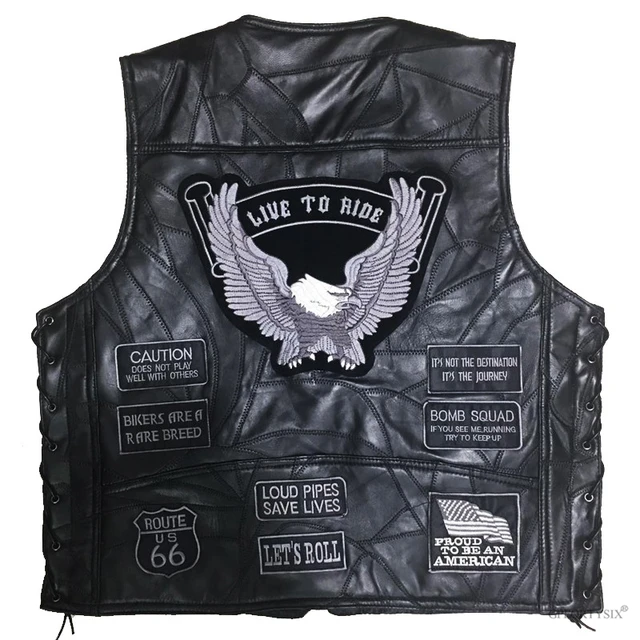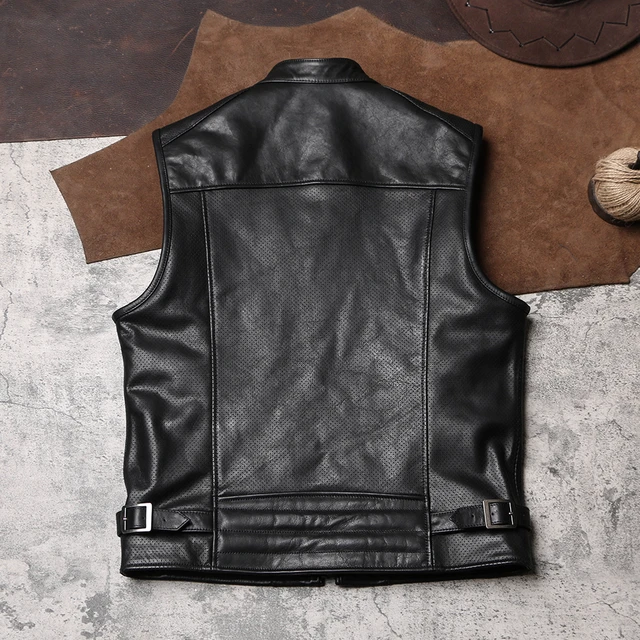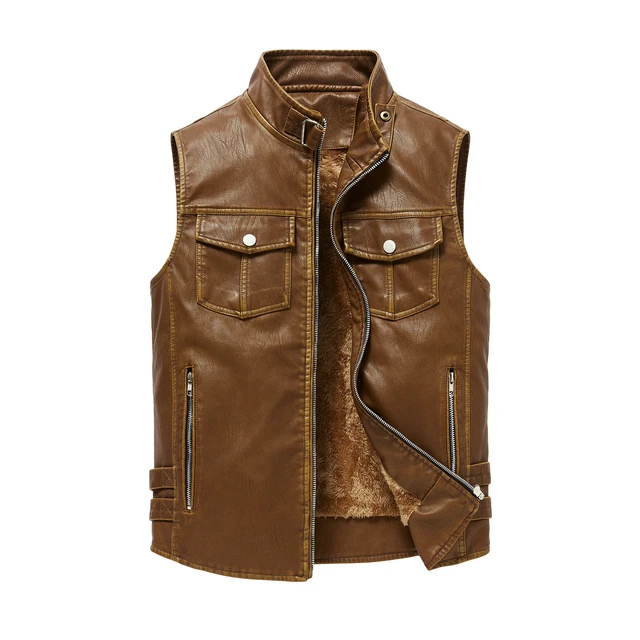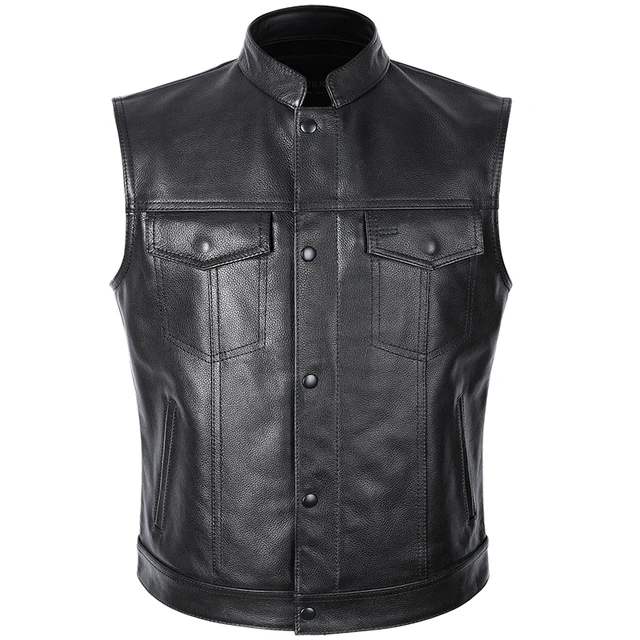Introduction:
Leather motorcycle vests are not just a staple of biker culture but also serve functional purposes. They provide an extra layer of protection, storage solutions, and a platform for personalization with patches and emblems. This comprehensive guide explores the key features, benefits, and considerations for choosing and maintaining a leather motorcycle vest.

Leather Motorcycle Vest:
What Are the Key Features and Benefits?
Material Quality:
How Does the Type of Leather Affect a Motorcycle Vest’s Performance?
The quality and type of leather used in a motorcycle vest significantly impact its durability, comfort, and protection.
Types of Leather:
Understanding Leather Varieties:
Cowhide Leather: Cowhide is the most common type of leather used for motorcycle vests. It’s known for its durability, thickness, and resistance to abrasion. Cowhide leather is excellent for protection against road rash in the event of an accident.
Buffalo Leather: Buffalo leather is another robust option, known for its superior strength and rugged texture. It’s typically thicker and more durable than cowhide, offering excellent protection and a unique look.
Goatskin Leather: Goatskin is lighter and more flexible than cowhide and buffalo leather. It provides a balance of comfort and durability, making it a suitable choice for riders who prioritize mobility and comfort.
Leather Grades:
Different Levels of Quality:
Top-Grain Leather: Top-grain leather is the highest quality and most durable type of leather available for motorcycle vests. It’s made from the outer layer of the hide and retains the natural grain, providing a strong and beautiful finish.
Full-Grain Leather: Full-grain leather is the most natural and least processed type of leather. It shows natural imperfections and is highly durable, developing a unique patina over time.
Split Leather: Split leather, or suede, is made from the inner layers of the hide. It’s less durable than top-grain or full-grain leather but is often used in combination with other materials for cost-effective options.

Design and Fit:
What Design Elements Should You Consider for Optimal Comfort and Style?
The design and fit of a leather motorcycle vest are crucial for ensuring comfort, functionality, and style.
Fit and Sizing:
Achieving the Right Fit:
Accurate Measurements: Taking accurate measurements is essential for finding the right fit. Use a measuring tape to measure your chest, waist, and torso length. Compare these measurements with the size chart provided by the manufacturer.
Adjustable Features: Look for vests with adjustable features like side laces or buckles. These allow for a customizable fit that can accommodate varying layers of clothing underneath.
Comfort and Mobility: Ensure the vest provides enough room for comfortable movement without being too loose. The vest should fit snugly but comfortably, allowing you to ride without restriction.
Design Elements:
Function Meets Style:
Collar Styles: Leather vests come in various collar styles, including classic collars, mandarin collars, and collarless designs. Choose a style that complements your overall look and provides the desired level of comfort.
Pocket Configuration: The number and placement of pockets are vital for functionality. Look for a vest with sufficient pockets for storing essentials like your phone, wallet, and keys. Interior pockets add extra security for valuables.
Zippers and Closures: The type of zipper or closure system affects the vest’s ease of use and security. Heavy-duty zippers and secure snap closures ensure reliability and durability during rides.
Protection and Safety:
How Does a Leather Vest Enhance Rider Protection?
While leather motorcycle vests are not a substitute for full protective gear, they offer certain safety benefits.
Abrasion Resistance:
Durable Protection:
Leather Strength: High-quality leather, such as top-grain or buffalo leather, provides excellent abrasion resistance. In the event of a slide or fall, a leather vest can protect your torso from road rash and minor injuries.
Layering: Wearing a leather vest over other protective layers, such as armored jackets or padded shirts, enhances overall protection by providing an extra barrier.

Visibility and Reflective Elements:
Enhancing Safety:
High Visibility: Some leather vests come with reflective strips or patches that improve visibility during night rides. Increased visibility helps prevent accidents by making you more noticeable to other road users.
Customization for Visibility: Consider adding reflective patches or strips to your vest if it lacks built-in reflective elements. This customization can enhance safety without compromising style.
Storage and Functionality:
What Practical Features Should a Leather Motorcycle Vest Include?
Functionality is a key aspect of a good leather motorcycle vest. Useful features enhance convenience and practicality on the road.
Pocket Variety:
Essential Storage:
Multiple Pockets: Look for a vest with a variety of pocket types, including chest pockets, hand pockets, and interior pockets. Multiple pockets provide convenient storage for personal items and riding essentials.
Secure Closures: Ensure pockets have secure closures, such as zippers or snaps, to keep items safe while riding. Interior pockets are ideal for valuable items like your phone or wallet.
Holster Compatibility:
Carrying Essentials:
Weapon Holsters: Some leather vests include built-in holsters for carrying firearms. If this is important for you, ensure the vest has a properly designed and secure holster compartment.
Concealed Carry Options: For those who prefer concealed carry, look for vests with discreet interior pockets that offer secure and accessible storage for weapons.
Ventilation and Weather Adaptability:
Comfort in Varying Conditions:
Ventilation Panels: Riding in hot weather can be uncomfortable. Vests with ventilation panels or perforated leather provide better airflow, keeping you cool during rides.
Weather Resistance: While leather is naturally water-resistant, it isn’t waterproof. Consider vests with integrated rain liners or treat your vest with leather conditioning products to enhance weather resistance.
Customization and Style:
How Can You Personalize Your Leather Motorcycle Vest?
Customization is an integral part of biker culture. A leather vest offers a canvas for personal expression and individuality.
Adding Patches:
Personal Statements:
Club Affiliation: Many riders add patches to represent their motorcycle clubs. Position patches according to club guidelines, typically on the back and front of the vest.
Personal Emblems: Personalize your vest with patches that reflect your interests, achievements, or personality. Ensure patches are securely sewn on to withstand the rigors of riding.
Embroidery and Artwork:
Unique Designs:
Custom Embroidery: Consider adding custom embroidery for a unique touch. Embroidered names, logos, or designs can make your vest stand out and reflect your personal style.
Painted Artwork: Some riders opt for hand-painted artwork on their vests. Work with a skilled artist to create a design that showcases your personality and passions.

Maintenance and Care:
How Should You Properly Maintain a Leather Motorcycle Vest?
Proper maintenance ensures your leather motorcycle vest remains in good condition, prolonging its lifespan and appearance.
Regular Cleaning:
Keeping It Fresh:
Surface Cleaning: Wipe down the surface of your vest regularly with a damp cloth to remove dust and dirt. Avoid using harsh chemicals or excessive water, which can damage the leather.
Deep Cleaning: For a more thorough clean, use a leather cleaner designed specifically for motorcycle gear. Follow the manufacturer’s instructions for best results.
Conditioning the Leather:
Preserving Flexibility:
Leather Conditioner: Apply a quality leather conditioner to keep the leather supple and prevent it from drying out and cracking. Conditioning also helps maintain the vest’s appearance.
Frequency: Condition your vest at least a few times a year, or more often if you ride frequently or in harsh conditions.

Storing Your Vest:
Proper Storage Solutions:
Cool and Dry Place: Store your leather vest in a cool, dry place away from direct sunlight and heat sources. Prolonged exposure to heat and sunlight can cause fading and deterioration.
Hanging Storage: Use a padded or wide hanger to store your vest. This prevents stretching or misshaping. Avoid folding the vest, as it can create creases and weaken the leather.
Avoiding Damage:
Protecting Your Investment:
Minimize Exposure to Elements: Leather can be sensitive to moisture and extreme temperatures. Minimize exposure to rain, direct sunlight, and extreme heat to maintain the leather’s quality.
Repairing Minor Damage: If your vest suffers minor damage, such as small tears or scratches, address them promptly with leather repair kits or professional services. Early repair prevents further damage and prolongs the vest’s lifespan.
Conclusion
A leather motorcycle vest is a valuable piece of riding gear that combines protection, functionality, and style. By understanding the different types of leather, design elements, and features to look for, you can choose a vest that meets your needs and preferences. Proper care and maintenance ensure your vest remains in top condition, providing reliable protection and lasting style for many rides to come. Customization allows for personal expression, making your vest truly unique. With these insights, you can fully appreciate the benefits of a leather motorcycle vest and incorporate it seamlessly into your riding experience.

